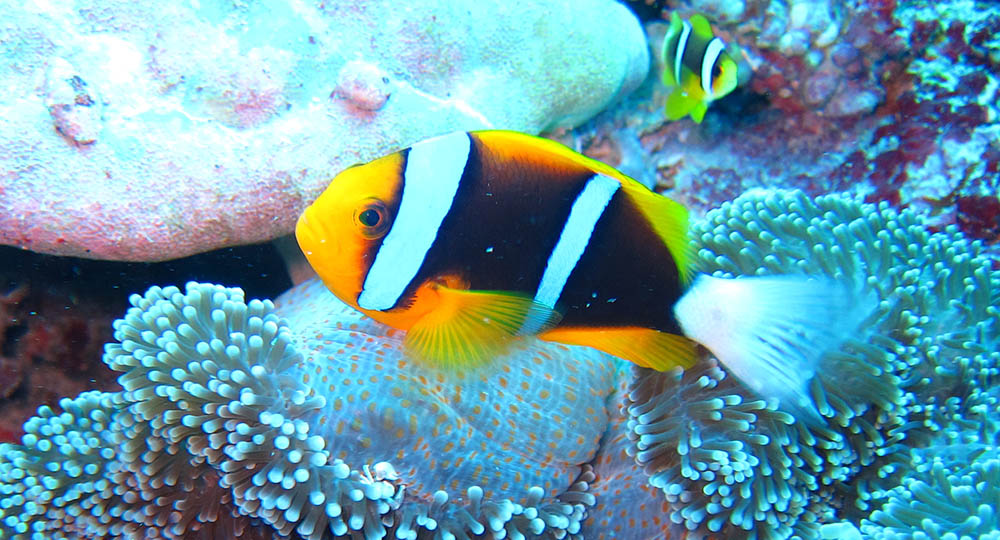
Amphiprion chrysopterus “Palau”, one of many variations found within the Clarkii-complex of Anemonefishes, the largest and most diverse species assemblage within the family. Image by Flickr user jeff~, cropped | CC BY 2.0
Genetics | Hybrids | Species Part 1| 2 | 3 | 4 | 5 | 6a | 6b | 6c | 6d | 6e | 7 | 8 | Index
Geographic Variants Within the 30 Current Species of Clownfishes – The Clarkii Complex
Considering the prior observations of Anemonefish enthusiasts, and surveying the observed geographic variants of Anemonefishes
by Matt Pedersen
Clarkii Complex
Amphiprion akyndinos – There is some variation within this species; some individuals appear more honey/orange colored, while others are more tan. Small juveniles may even appear dark, to almost black. Some fish seem to exhibit blue stripes, while others tend to be more white. At this time, these subtle differences haven’t been correlated to geographic sources; it is suggested by Yuri Barros that they are a function of host choice.
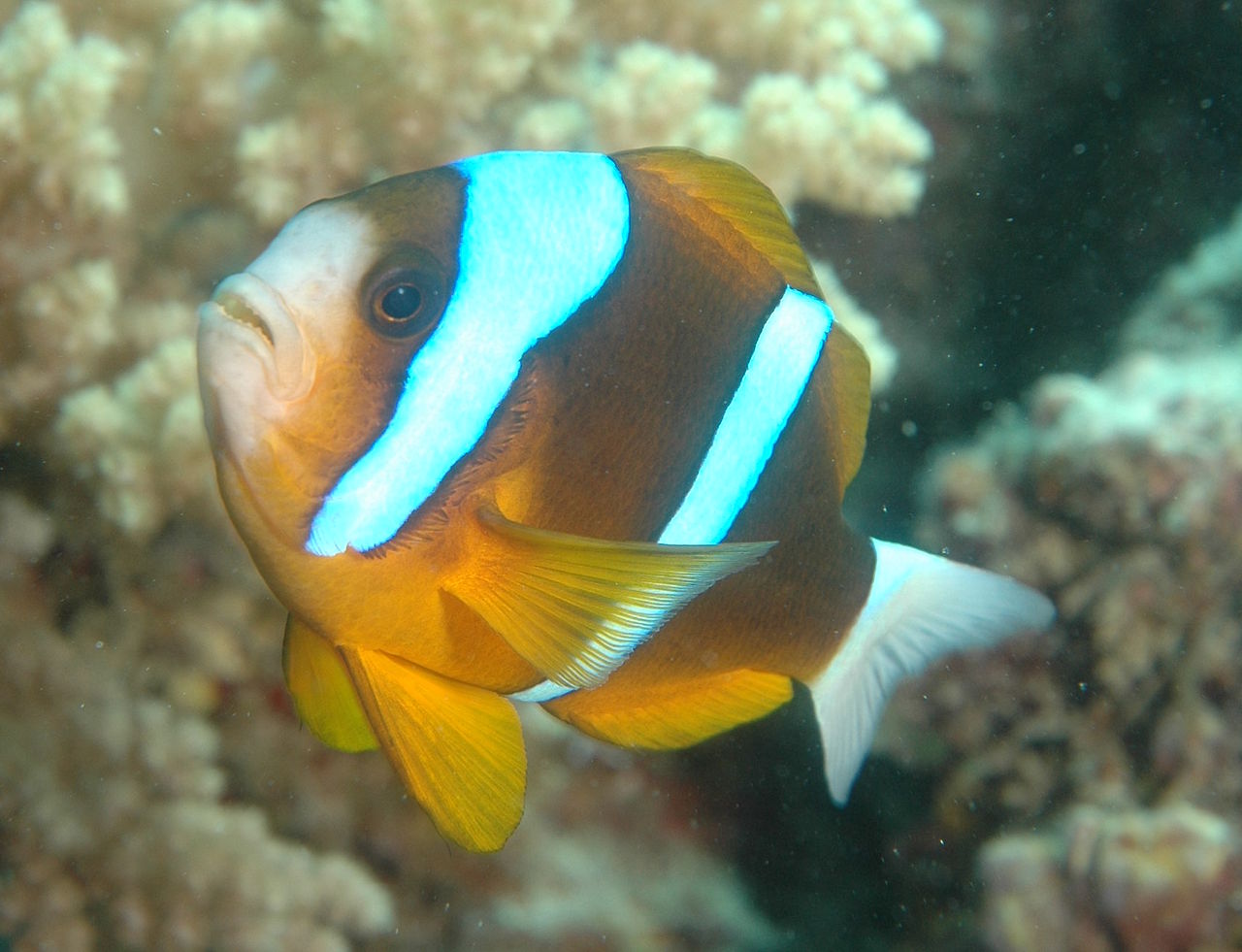
Amphiprion akyndinos on the Great Barrier Reef at Cairns, Australia – image by Leonard Low – Wikimedia / Creative Commons
Amphiprion allardi – This species, coming from the eastern coast of Africa, is generally quite uniform in adult appearance. Individuals varying from the norm, showing black dorsal, anal and pelvic fins have been observed, but there is no known geographic tie, presuming this to be a simple aberrant form. Barros showed that a melanistic form has been documented off Tanzania as well.
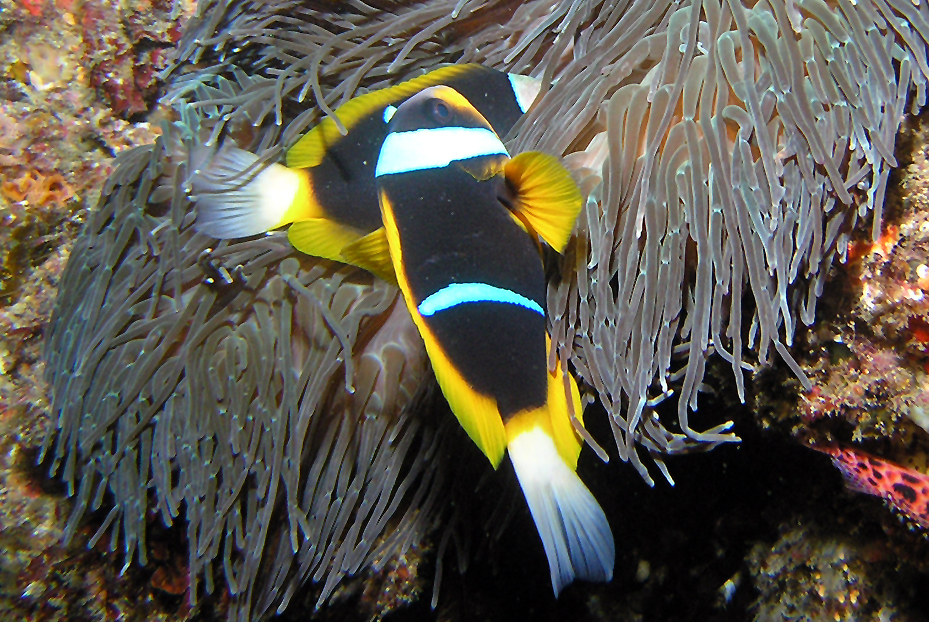
Allard’s clownfish, Amphiprion allardi; Taken diving on Aliwal Shoal off Umkomaas, KwaZulu Natal, South Africa – by Flickr User Rob / Wikimedia / Creative Commons
Amphiprion bicinctus – There is a fair amount of variability in the coloration of this species; most of this seems to be tied to maturity and sexual role, and not geography. Stripes can be white or blue, and as Kylie Waldon notes, “variants (both male and female) with bright blue bars are nearly always found in [Entacmaea quadricolor] rather than any other host.”
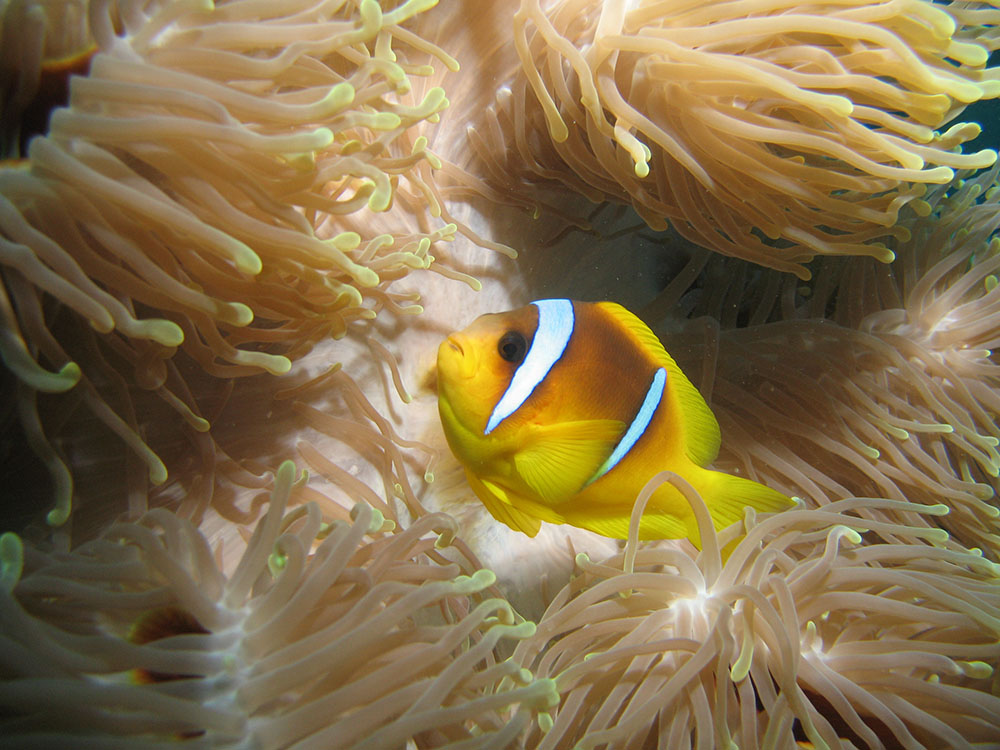
Amphiprion bicinctus near Marsa Alam, Egypt, by Magnus Kjaergaard – Wikimedia | Creative Commons BY-3.0
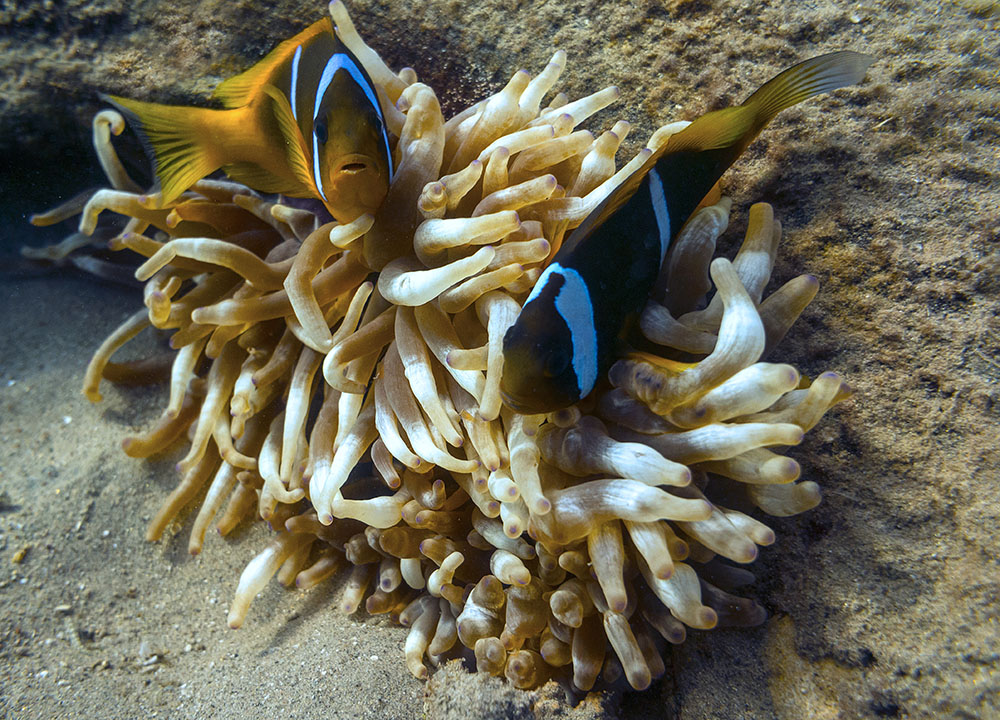
Amphiprion bicinctus at Bannerfish Bay dive site, Dahab, Egypt – photo by Malcolm Browne – Flickr / Creative Commons BY-ND
Amphiprion chagosensis – coming only from the Chagos Archipelago, there are no geographic variants. This is a species that due to its location will likely never enter the aquarium trade; it is one of the only species that to date has not been bred in captivity. It is at times difficult to even find a reliable photograph; some of the specimens shown in the wild appear to be A. bicinctus, which is also reported to occur in Chagos. It is worth noting that genetic research has actually revealed this species to be most closely related to A .nigripes in the Skunk-Complex, casting doubt on its inclusion in the Clarkii-Complex. One known image of a juvenile Chagos Anemonefish suggests that these fish might lack the traditional tail and dorsal flags (upper white margins on the caudal and soft-dorsal fin) which seem to be present in all other Clarkii-complex species, although a second image might suggest otherwise (or it might simply show a sympatric juvenile of A. bicinctus). For some additional images, see examples #1, #2, #3, #4, #5, #6, #7). Check out the video below, at 13:55, and 18:15, for some extremely rare footage of A. chaogsensis in the wild.
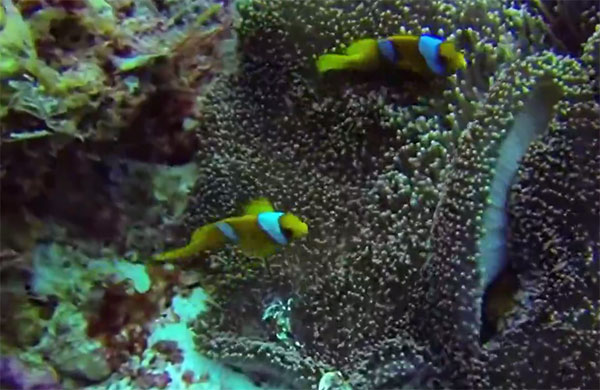
Screencapture from Jason Zarudny’s Diego Garcia video below, showing the endemic Amphiprion chagosensis.
https://www.youtube.com/watch?v=QuyfErc86e0
Amphiprion chrysogaster – we call this the Mauritian Clownfish, but Barros points out that the species may also be found at the Adaman & Nicobar Islands in the Indian Ocean; Barros even uncovered an image suggesting the occurrence of this species off Oman. Still, this species enjoys a very limited geographic range, and as such, would not be expected to have any geographic variants; the darkening of color is tied to maturity.
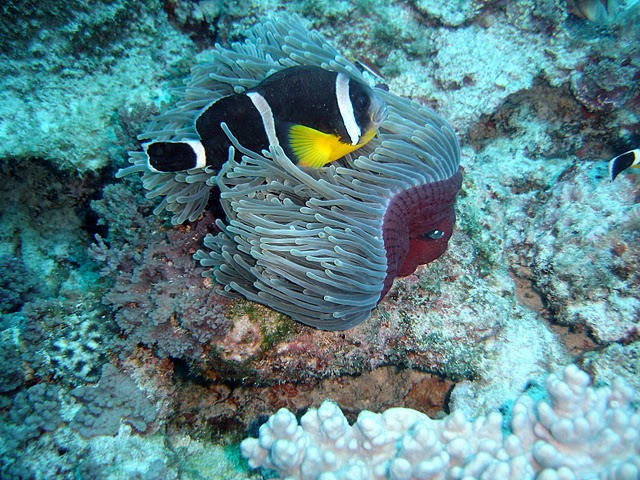
Amphiprion chrysogaster in the wild – Photo by “Eric” – Creative Commons / Wikimedia
Amphiprion chrysopterus – Clownfish enthusiasts and aquarium importers have long known that not all Blue Stripe Clownfish are the same. When I first drafted this article, I wrote there were 3 variations, but possibly as many as 5 or 6. When conferring with Barros, I was rapidly convinced that there are definitively now 4 solid groups all underneath this species, and all of these groups have geographic ties. At least one of these groups could probably be split off into a new species. I wrote about this at great length in the preceeding section, but will recap the forms here:
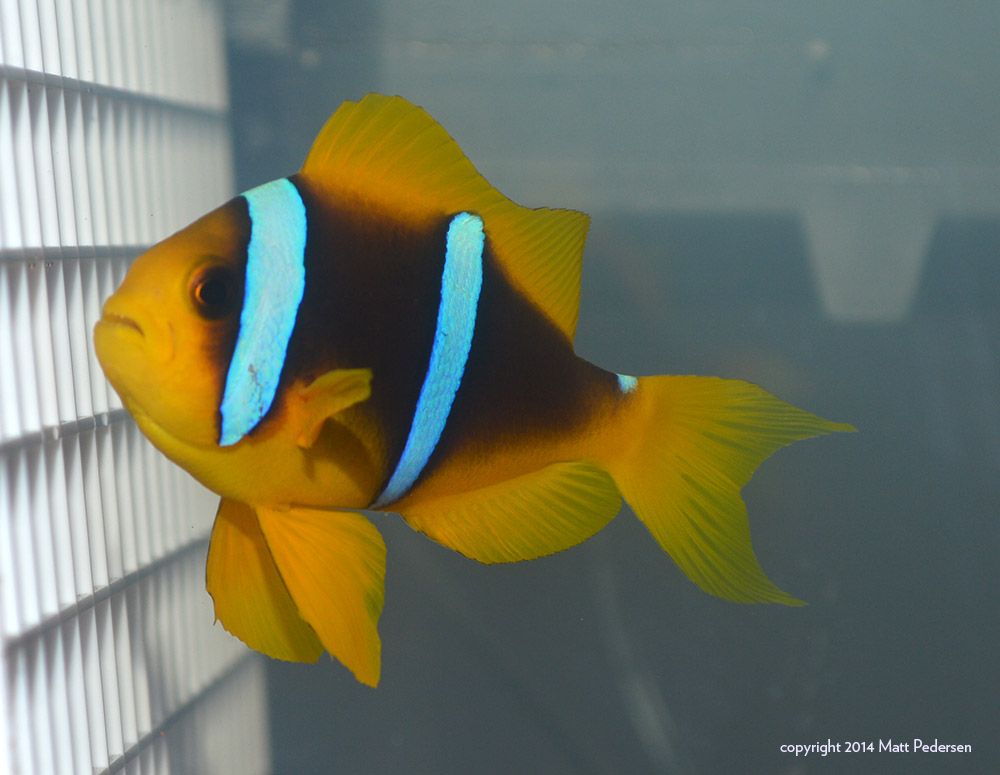
Amphiprion chrysopterus from Fiji, an example of the Yellow-tailed, Yellow-finned phenotype. Image by Matt Pedersen
#1. The first phenotypic group consists of yellow tail, yellow fin varieties (YT/YF). This form has been documented in Fiji, Tonga, American Samoa, and Niue.
#1a (or #5 if you prefer). This phenotype is also seen in the Mariana Islands and Guam which is geographically quite separated from the same phenotype in the south. Barros currently believes this northern group at minimum represents a distinct population from the more southern grouping; geography certainly would suggest that there isn’t genetic interchange between these two populations, but visually they appear to be the same fish.
#2. A second familiar form has a white tail with yellow fins (WT/YF). This form is found in Palau, Yap, the Caroline Islands, Chuuk, Pohnpei, Kosrae Island, and the Marshall Islands; it is also found in Vanuatu and New Caledonia, as well as a dubious photographic reference to this form being in Komodo, Indonesia. In the Coral Sea, documentation shows the WT/YF form existing side by side with the third phenotypic group.
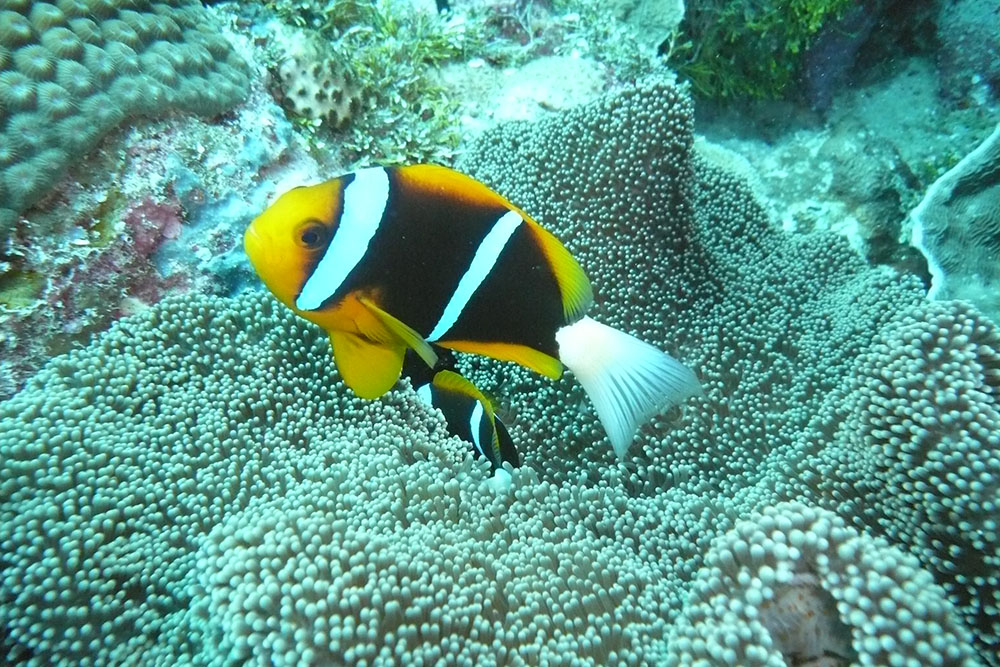
White Tail, Yellow Fin form of the Blue Stripe Anemonefish, A. chrysopterus, photographed at Siaes Tunnel, Palau, by LuxTonnerre – Wikimedia | Creative Commons
#3. The third geographic phenotype consists of specimens which have white tails but black anal and pelvic fins while dorsal fins remain yellow/orange (WT/BF); we could also call this a “Blackfooted Blue Stripe” in deference to the coloration of A. nigripes, aka. the Blackfooted Clownfish. This third type is geographically restricted to Irian Jaya, Papua New Guinea, the Solomon Islands, Australia’s Great Barrier Reef, and the Coral Sea. This form is of particular interest given the recent publication The radiation of the clownfishes has two geographical replicates, by Glenn Litsios et. al., which stated “The position of A. chrysopterus from the Solomon Islands is surprising and most of the nodes that separate this individual from the two other A. chrysopterus we sampled are weakly supported. One possible explanation is that the specimen from the Solomon Islands descends from a hybridization event between A. chrysopterus and, most probably, A. akindynos. Hybridization occurs between clownfishes and has led to the description of two species that are now recognized as hybrids (A. leucokranos and A. thiellei). Further investigation is necessary to understand whether or not A. chrysopterus from the Solomon Islands is truly a hybrid or represents an undescribed species.”
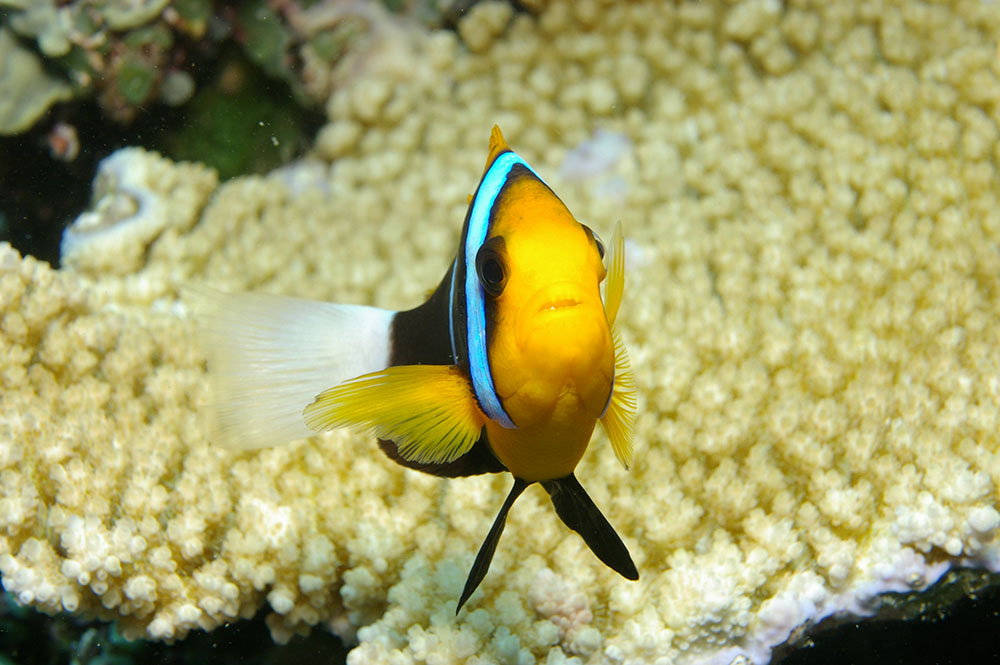
The White Tail, Black Anal/Pelvic fin variant of A. chrysopterus, this one photographed in PNG by Jon Radoff – Wikimedia / Creative Commons
#4. The fourth type, demonstrated by Barros and with which I’ve come to agree, hails from the far eastern edge of this species range; specimens from Tahiti, Mo’orea, Bora Bora, and the Tuamotus Islands. It is once again a yellow-tail, yellow-fin form, but the striping is noticeably narrower among this geographic cluster, and body coloration is in general a light yellow/orange, with dark coloration primarily only along the upper rear portion of the flank. I’ve added the “narrow bar” demarcation for the time being (YT/YF/NB) – the videos below show examples of this form from Tahiti, Bora Bora, and Moorea.
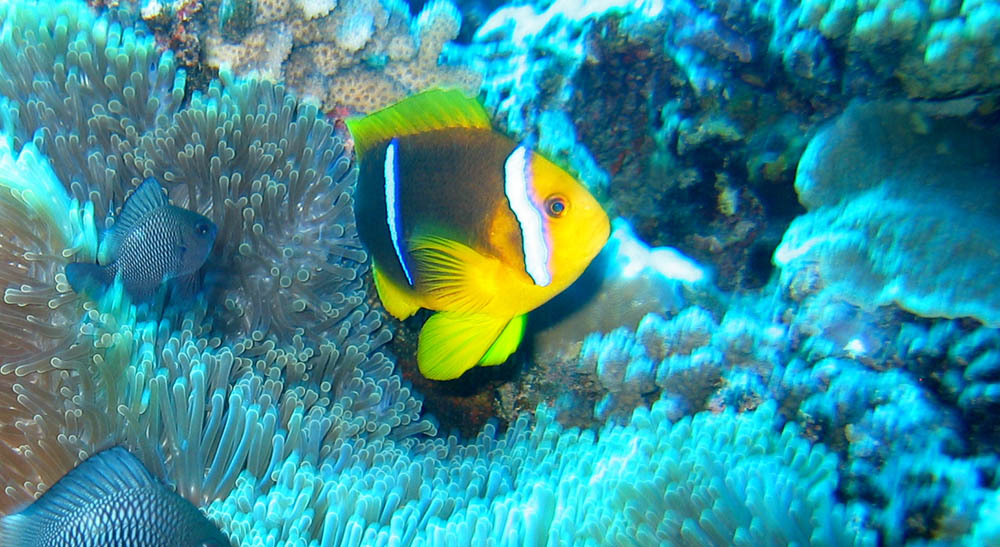
A. chrysopterus in Tahiti, where bars are extremely narrow and often don’t connect on the headstripe in mature fish. Image cropped from original – by Manoel Lemos | Flickr | CC BY 2.0
https://www.youtube.com/watch?v=2CVtAnCU8ok
#5. See #1.
Clearly, one cannot identify the precise geographic location of an adult Blue Stripe Clownfish just by looking at it; however, you can know with some certainty that a provided geographic source is incorrect if the fish does not match the form that is native to the purported collecting locale. It is quite possible that, in time, we will see this cluster of fish be split at least in two, but conceivably as many as 4 or 5 distinct taxonomic species.
Amphiprion clarkii – this species is well known as a wide ranging and widely variable species; variations in coloration can be seen within an isolated population, with differing colors on individual fish that may be tied to sex role, maturity, or host choice (which can cause melanistic coloration to appear quickly even on a normally colored fish and may, or may not, be passed on to offspring). Barros has documented and made the argument for potentially 11 unique geographically distinct population clusters; outwardly I’m not sure whether I agree with all the lines drawn at the moment, but that is certainly open to further examination. I certainly of the opinion that there are at least a few species all lumped together, and there are certain areas where my opinions mesh well with those of Barros.
From ongoing conversations,Barros has convinced me that there are two overarching groups; Barros clearly defines the yellow-tail forms which lack sexual dichromatism, in contrast to the white-tailed forms, which show varying degrees of of sexual dichromatism from none to very notable differences in caudal fin coloration.
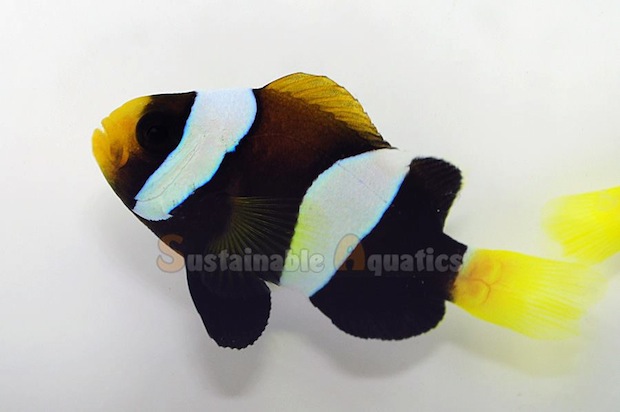
The “Australian Black Clarkii” being produced by multiple commercial breeders now – this one courtesy Sustainable Aquatics
#1. A very distinct Black Clarkii form entered the trade from western Australia, sharing a slimmer body actually more similar to A. sebae in some respects. Barros would consider this to be one of the yellow-tail Clarkii varieties. The banding pattern is very reminiscent of A. sebae as well. Furthermore, this “clarkii” shares apparently shares some of the juvenile coloration of A. sebae as well, with juveniles in breeding showing black central coloration on the caudal fin. These Australian Black Clarkii appear to breed true to form, which suggests a distinct biogeographical genetic form – their black coloration doesn’t appear to be host-driven melanism. These are the fish Barros cites as the Western Australian Black Clarkii from Ningaloo Reef. It would take some further detective work to determine whether current captive-bred “Black Australian Clarkii” stocks are in fact derived from this unique Indian Ocean population in the far west of Australia, but they match well and truly, there isn’t another wild Clarkii out there that remotely looks similar. This form is so unique, and so unlike any other clarkii, that I have gone so far as to propose that this form is a unique species, possibly even being the product of a hybrid merging of two ancenstral forms, one related to the Polymnus complex and the other the Clarkii complex.
#2. Another obviously unique variation is found in Vanuatu (Barros lumps this with New Caledonia), having a reduced dark patch on the upper rear flank, the main background body color being bright orange and in adults, the third caudal-stripe is absent (see Vanuatu examples 1, 2, 3, 4). Black forms of A. clarkii also show up in images claimed to be from Vanuatu; it is possible if not likely that these black fish from Vanuatu are displaying host-driven melanism. Barros would consider this a yellow-tailed form.
https://www.youtube.com/watch?v=KdyECcZd5Ss
#3. Similar to the Vanuatu Form, vibrantly colored Clarkiis are found around the Solomon Islands, Coral Sea, Papua New Guinea, and the Great Barrier Reef. It is interesting to point out that this population distribution matches the geographic range of one particular form of Amphiprion chrysopterus. These fish all consistently have a solid yellow tail, strong orange coloration in the ventral and anal fin, with reduced darkness in the body and sometimes, even an orange chest. It would seem that while Vanuatu forms lack any sort of white caudal peduncle band, this group can have it, but doesn’t consistently show it. It could well be that this group, and the proceeding, should be considered the same, and Barros would call these yellow-tailed forms.
Once again, host-driven melanistic forms occur within these populations.
Here’s an example of the melanistic variation seen at the Solomon Islands.
#4. Barros makes a compelling case for the Bonin Islands (Ogasawara Islands) population of A. clarkii which was originally described as Amphiprion snyderi (Ishikawa, 1904), heavily referencing the work for Jack T. Moyer and supporting the variation with extensive photography. This fish starts out life as an orange juvenile with three black bars, but matures into a solid black fish with white bars and a white tail; no hints of yellow, orange or brown coloration present, and the black coloration is not caused by the hosts typically responsible for host-induced melanism. Barros would treat these as white-tailed forms which lack sexual dichromatism. My thanks to Barros for pointing me to this video below:
#5. While many of us likely think of the Philippine form of A. clarkii as the ‘true’ or “classic” clarkii, likely because these were the most common forms in the trade over the years past, Barros wisely cites the Indian ocean form as the “original”, noting that Bennett described the fish in 1830 from the Indian Ocean. Seeing these specimens with consistent black bodies, slightly more narrow stripes, dark dorsal fins and bodies, and bright yellow tails, it is very easy to understand how this species may have first become confused with A. sebae. However, the third bright white band at the base of the tail clearly distinguishes these fish at a distance, and this form is part of Barros’ yellow-tail grouping.
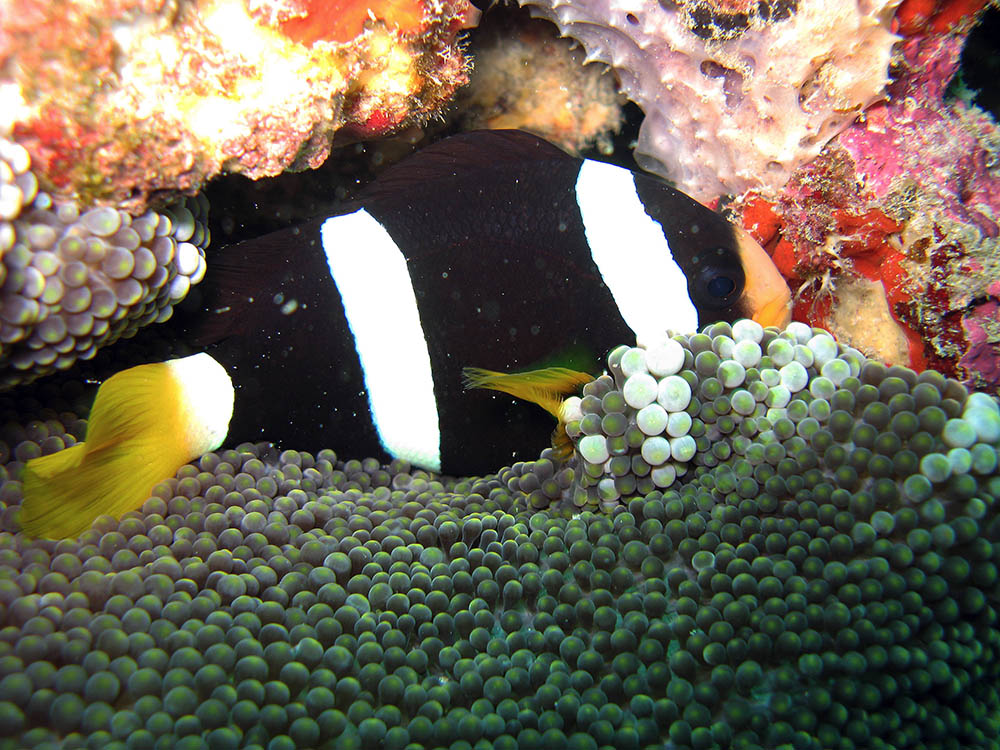
A. clarkii photographed in the Adaman Sea, Thailand, by Silke Baron – Wikimedia | Creative Commons
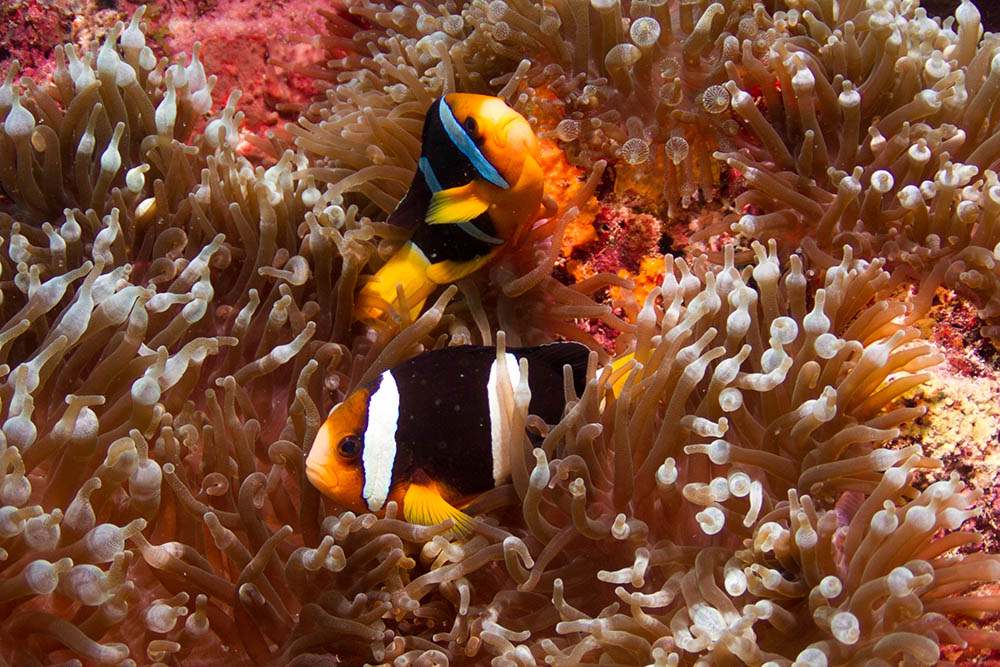
Indian Ocean Clarkii from Maale, Maldives, by Flickr user Tchami – Flickr / Creative Commons BY-SA
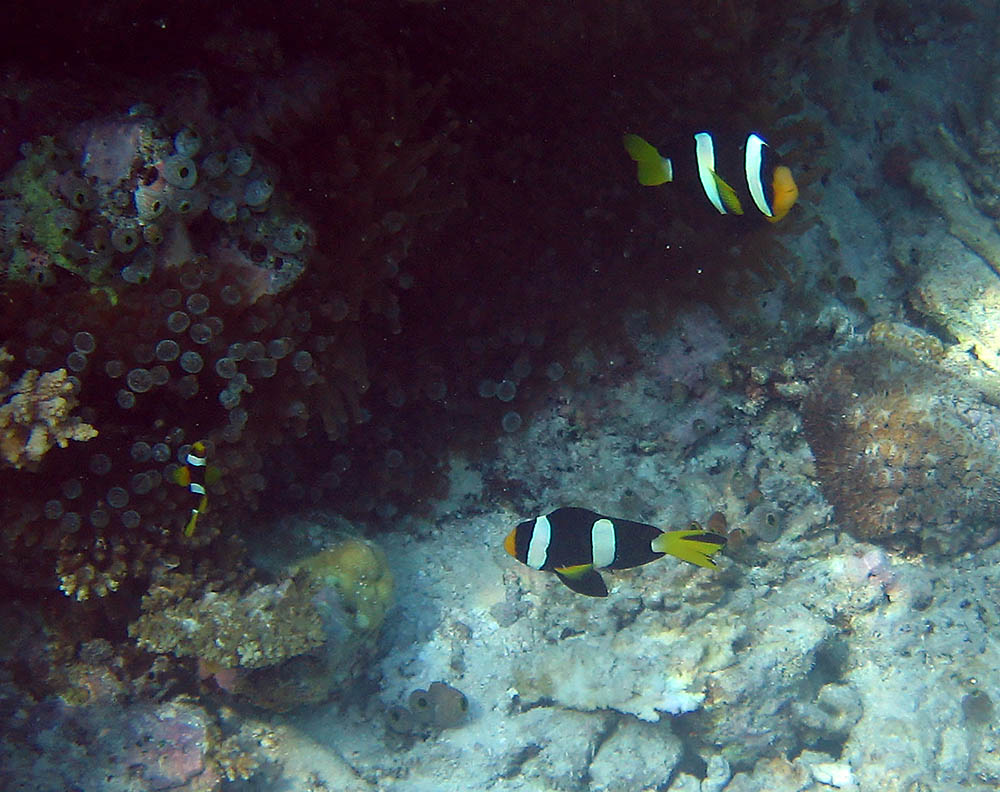
Another example of A. clarkii from the Maldives, this time showing the melanistic variation – note the differing coloration of the anal and ventral fins. Image by Christian Jensen, image cropped | Flickr / Creative Commons BY
#6. This leads into the classic Clarkii clownfish from the Asian region including the Philppines, which Barros refers to as the Wallecea variant. These are the classic Clarkii with dark backs, burnt orange chests, white tails, moderately wide bars, and in some specimens bright yellow edges on the top and bottom of the tail. These yellow edges are generally considered signs of sexual dichromatism and said to occur in males, and would be part of Barros’ white-tailed group.
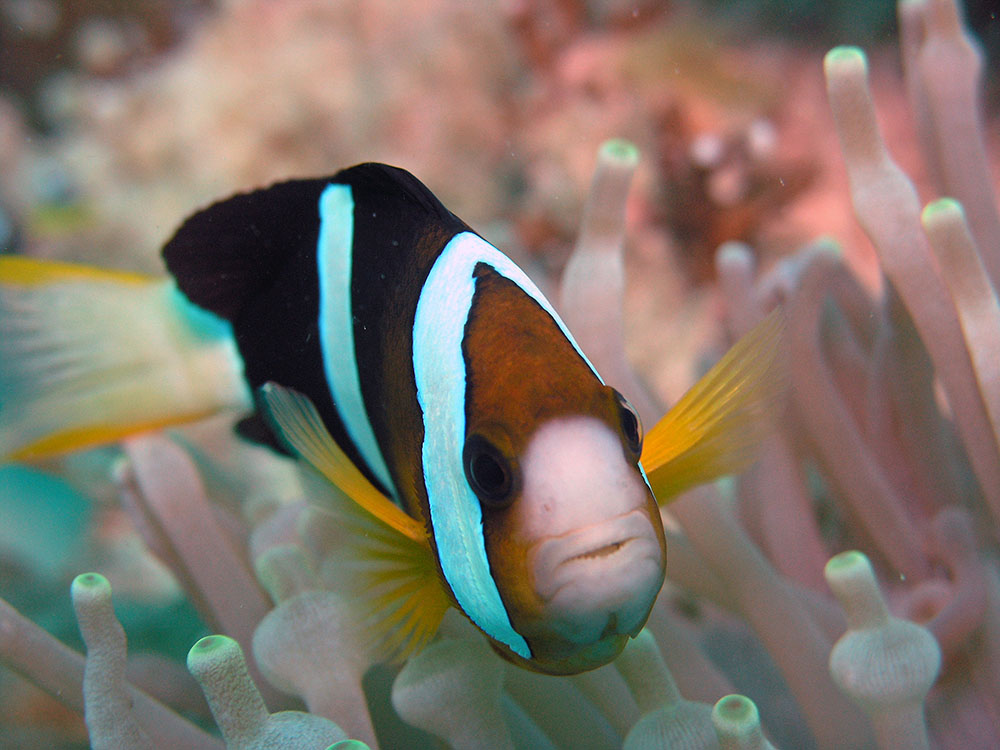
Clark’s anemonefish. Amphiprion clarkii, of Barros’ Wallacea variety. Taken at Sipadan, Borneo, Malaysia, by Jens Petersen – Wikimedia / Creative Commons
Additionally, it bears mentioning that Yuri Barros cites several lesser-known unique biogeographical populations as being distinct and noteworthy:
#7. Further to the north, Barros well demonstrates the transition and replacement of the typical “Wallacea” form with a similar variety found in Japan; the main difference is that males will have solid yellow tails vs. simply having yellow upper and lower edges, part of the white-tailed group. This form once described as Amphiprion xanthurus (Cuvier, 1830):
#8. Mariana Islands and Guam, where males have a yellow band at the posterior edge of their white tail, while female’s tails are all white, again, making this a variant from Barros’ white-tailed grouping.
#9. Oman, where A. clarkii have yellow tails in both sexes (a yellow-tailed form), deep blue bands, and headstripes that are generally unconnected at the top. This fish is more often shown in photos of clownfish from Oman than the actual endemic A. omanensis!
#10. Palau/Yap/Chuuk/Caroline Islands, where both sexes always have solid white tails and are part of Barros’ white-tailed group (as seen in this video from Palau)
#11. The Christmas/Cocos Keeling Islands, where both sexes show creamy pale yellow tails; I believe Barros has not come to a decision on which group he believes this variation best fits into.
Ultimately, A. clarkii can have a diverse range of coloration on the fins and body, so much so that a great additional amount of work will need to be done within this species to suss out the possibility of hidden species. Yuri Barros has, by far, done the lion’s share of research on this topic to date. It is quite possible that with further review, we may even see further splitting of geographic races. Whether they’ll all remain under the A. clarkii umbrella is an unknown, but for the collector of the obscure and rare, you could become deeply engrossed in this species complex.
Amphiprion fuscocaudatus – occurs only in the Seychelles and as such, would not be expected to have any geographic variants. Another species not in the trade, although we would certainly welcome it with open arms; this is another clownfish species that has never been captive-bred (to the best of my knowledge).
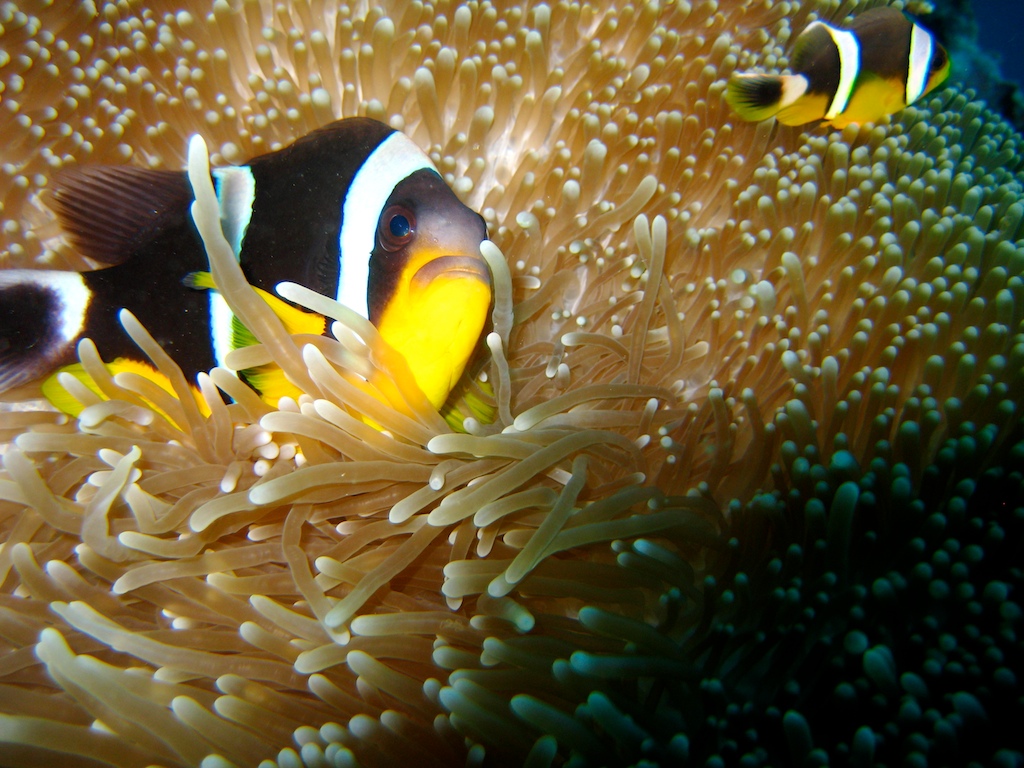
A very rare glimpse at Amphiprion fuscocaudatus in the Seychelles – by Greg Tee – Wikimedia / Creative Commons
Amphiprion latifasciatus – this species is general thought of as the Madagascar Anemonefish. Interestingly, Barros has possibly demonstrated three geographic variants, and perhaps even a fourth. One of the telltale signs that can help differentiate this species from relatives is the appearance of a darkness in the upper midstripe that reveals a somewhat scaled pattern; this isn’t seen in A. allardi, A. clarkii etc.
#1. Barros includes a type from southern Madagascar, where adults have a white tail which is edged in yellow on only the lower side (see example #1).
#2. Individuals from the northestern Madagascar have very wide bands, a dorsal fin edged in white, and a yellow tail edged in white (see examples #1, #2).
#3. Individuals from northwestern Madagascar and the nearby Comoro Islands have a fully yellow dorsal fin and caudal fin (see image below, see also Comoros, Nosy Be, Mayotte #1, Mayotte #2, juvenile at Mayotte).
#4. A fourth type, not currently tied to a particular geographic location, shows fish that have white tails with yellow edges on top and bottom (see examples #1, #2, #3. ) – these could be juveniles or intermediates of the Yellow Tail form (eg. this yellow edged fish from Mayotte) or some other type of polymorphism / dichromatism in the species (eg. this example, a mature fish from the southwestern shores of Madagascar at Nosy Ve, or this pair which shows arguably solid and “yellow edged” tails side by side back in the Comoros).

Amphiprion latifasciatus, the yellow-tailed variant, this one photographed at Mohéli, Comoros by Daryl Wallace (alKomar) | Wikimedia / Creative Commons
Amphiprion omanensis – another species with very limited distribution in the overall sense and as such, does not appear to show any geographic diversity. There is variation in color intensity ranging from tan and pink to deeper reddish hues. Some A. bicinctus develop long caudal extensions and even dusky coloration that can allude to the fish being A. omanensis; one of the seemingly consistent telltale differentiation is the color of the pelvic and anal fins; in A. omanensis the pelvic fins of mature fish are black, while A. bicinctus seem to always be yellow. Unfortuantely even this trait is not reliable; older, darker, captive-bred A. bicinctus have been shown to have dark if not black pelvic fins as well, which means finding a legitimate A. omanensis is arguably impossible as exportation of this fish from Oman isn’t permitted. See some examples of the wild fish in photos (example #1, #2, #3, #4), and in the videos below.
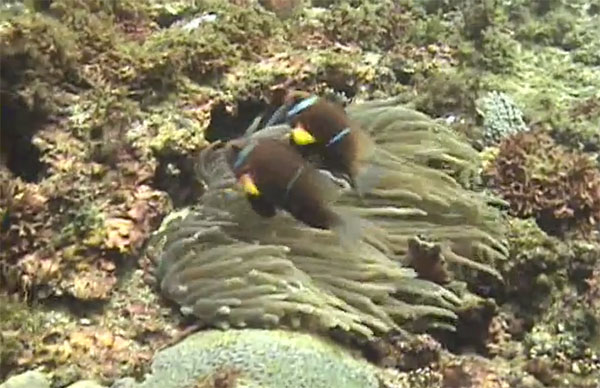
Another screenshot of A. omanensis in the wild, this from the below video by Youtube user csucjj. Start watching at 3:32 to see the clownfish.
Amphiprion tricinctus – This species has a restricted range in the Marshall Islands, and thus does not have any known geographic variation. However, this species has also truly demonstrated, firsthand, the plasticity of coloration in an individual clownfish. A. tricintus, at all life stages, is known to be black when residing in the sea anemone Stichodactyla mertensii; several other clownfish are known to adopt melanistic coloration when living within this anemone species. The default coloration of A. tricinctus is yellow-orange with white stripes as a juvenile; as adults A. tricinctus are generally a mix of orange below, shading to deep brown along the posterior half of the fish. That said, I’ve personally witnessed wild-collected adults go back and forth between solid orange with white stripes, to very dark coloration, all within the same system with no known external triggers. Even more interesting, I watched one turn to a darker phenotype while the other headed in the other direction.
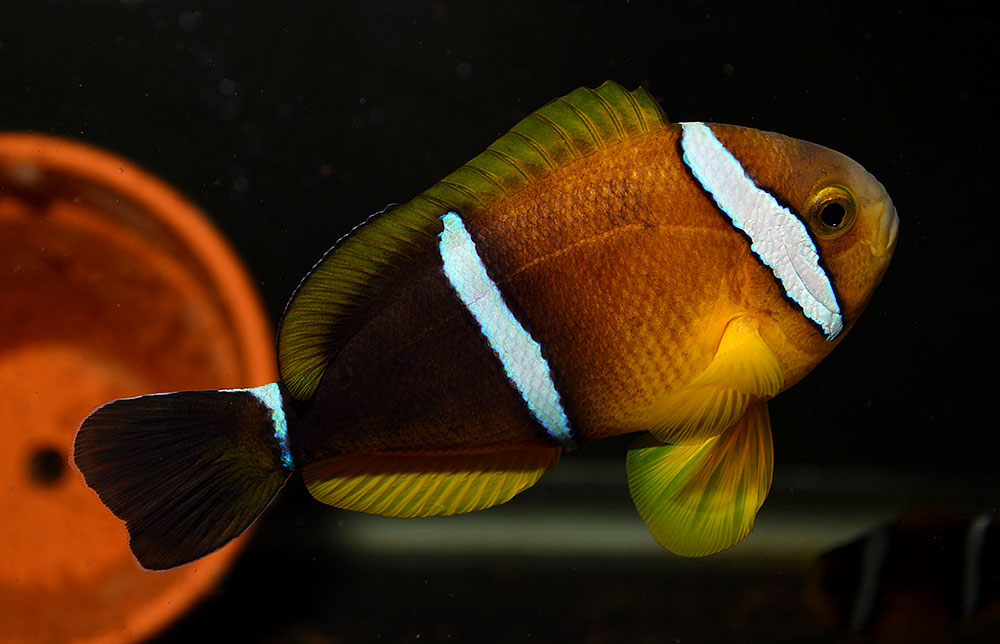
The typical coloration for the non-melanistic version of Amphiprion tricinctus – this wild-collected specimen from the Marshall Islands arrived much more lightly-colored. Image by Matt Pedersen.
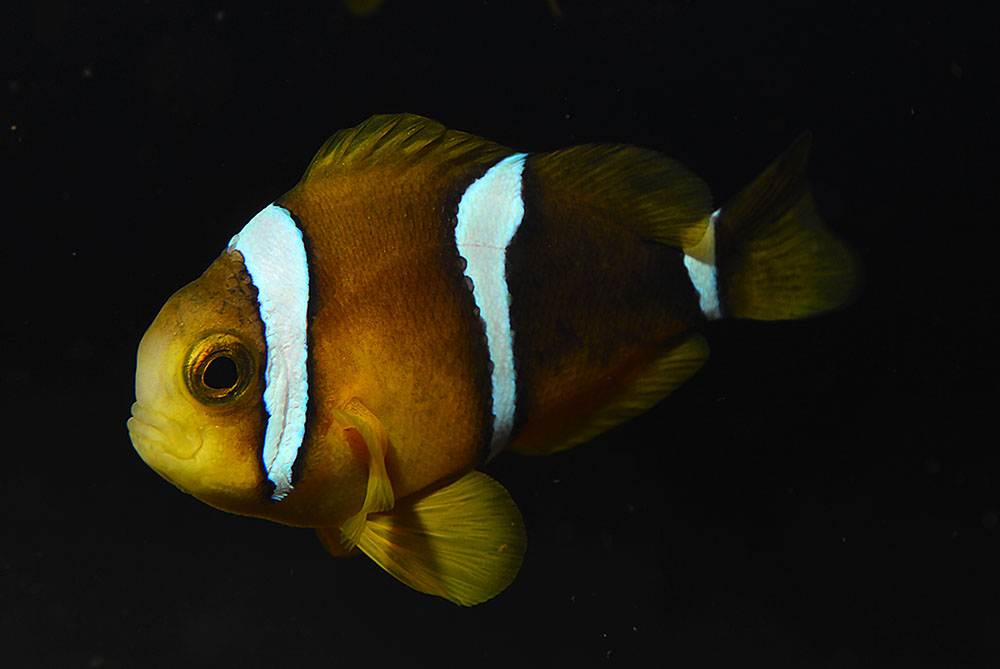
A captive-bred juvenile of A. tricinctus showing the typical coloration for the species. Image by Matt Pedersen.
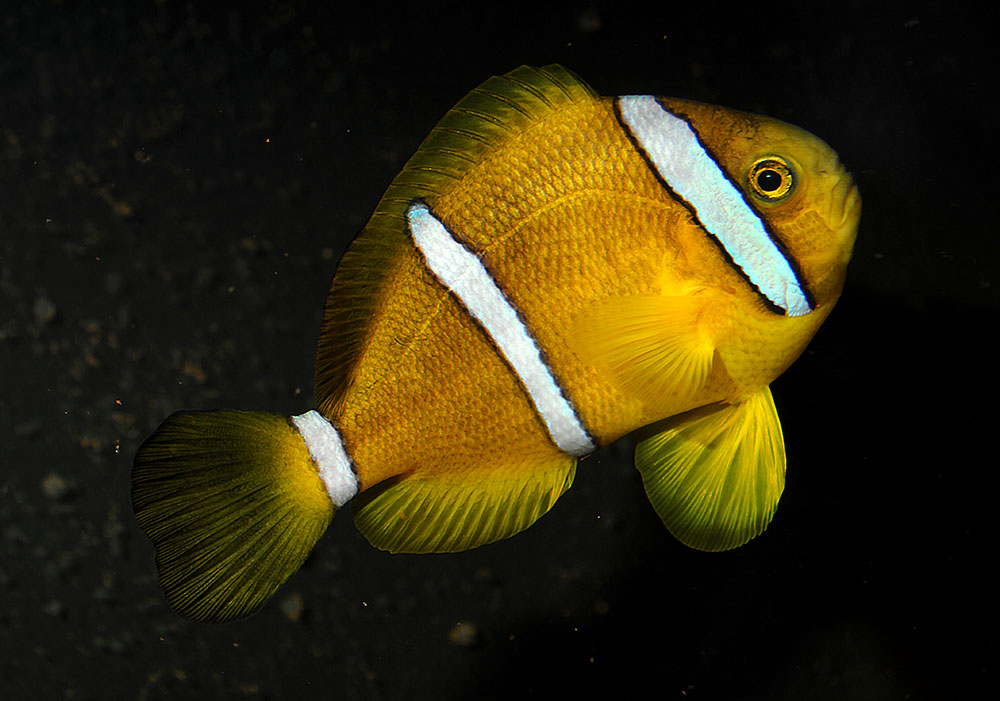
This wild caught individual of A. tricinctus arrived very darkly colored, but over the years has considerably changed color to a very light form. Image by Matt Pedersen.
Continue to the next section – The Role of Captive Propagation in Clownfish Preservation
Genetics | Hybrids | Species Part 1| 2 | 3 | 4 | 5 | 6a | 6b | 6c | 6d | 6e | 7 | 8 | Index
Photo Credits – all photos as credited in their captions.
References – Heavy credit is due to communication and data personally shared by Yuri Barros, most specificially in the Amphprion clarkii species group. I was perhaps aware of only 50% of the variants before speaking with Barros; his investigative work within this group is unparalleled and deserves further attention.
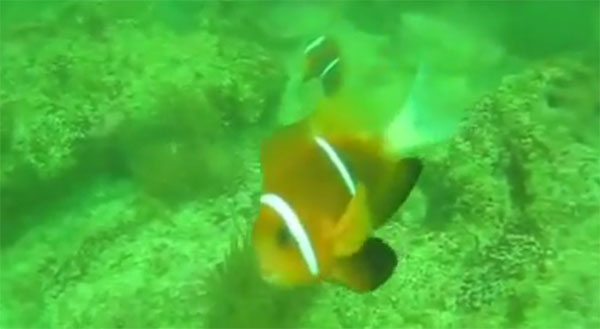





Matt! I’m a long time clownfish enthusiast/caretaker and wanted to inquire if you and or barros still publish pictures. I have lots of pairs for years and want to identify their locations. Hope to hear soon. Kind regards, Eric
Eric, in many cases, identifying clownfish to the geographic level could prove difficult. In reality, the only reliable way to know the biogeographic provenance of your fish is to try to get that collection information at the time of purchase, or otherwise try to go back up the chain to see if you can get the info. Years later, such detective work could simply prove impossible.